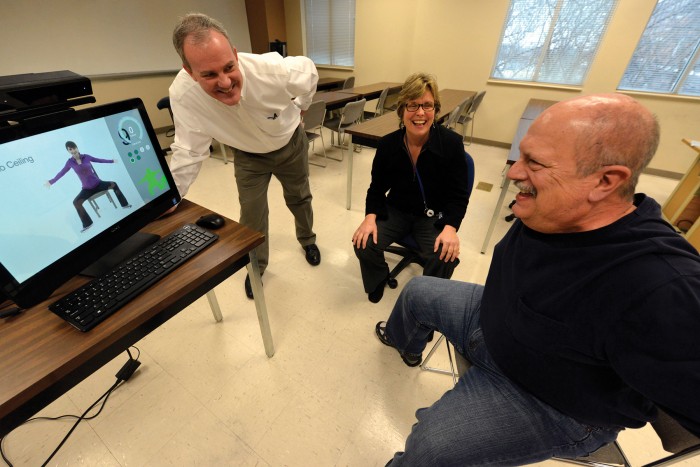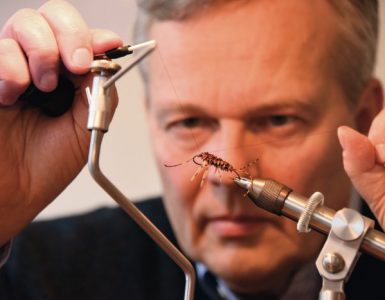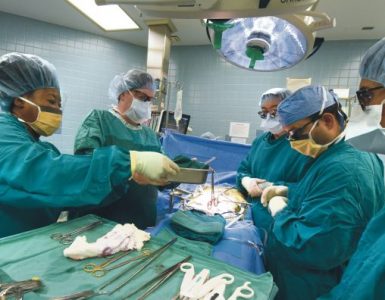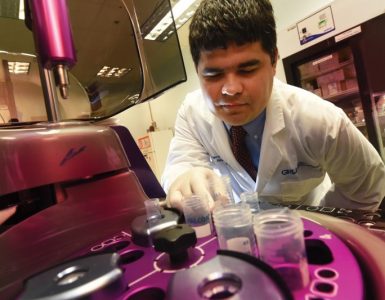
Parkinson’s Research Puts Motivation in Motion
JOE KELLEY knew how to hold a crowd’s attention.
He’d spent years providing nuclear training for the Savannah River Site. That’s exactly what he was doing one day 12 years ago. But rather than absorbing his instruction, the trainees spent the session staring at Kelley’s hands. When the following group did the same thing, Kelley knew something was wrong. The problem, he realized upon glancing down, was that his hands were shaking.
A visit to GR Medical Center solved the mystery.
“Four times (during the appointment), they used the phrase ‘Parkinson-like symptoms,’” says Kelley, whose pragmatic personality could never countenance such ambiguity, however well-intended. “After the fourth time, I said, ‘Do I have it or not?’ They said yes. I said, ‘OK, now I know what I’m dealing with.’”
Peering Into the Future
HE WAS 55 at the time, and his stoicism softened the blow. But Kelley, now 67, dared not peer too far down the road. “I couldn’t envision my future, and I didn’t want to,” he says. “But I’ve come around. Now, I can see my future, and I can help others.”
That help is manifesting itself in myriad ways, including Kelley’s role as Vice President of the CSRA Chapter of the National Parkinson Foundation. In addition to offering monthly meetings, luncheons, a newsletter, health fairs, and wellness programs to support patients and families dealing with the disease, the chapter also supports research. And in very few spots on the globe is that research as robust as it is at Georgia Regents University. GRU’s Movement Disorders Clinic, overseen by Medical College of Georgia Professor of Neurology Kapil D. Sethi, offers top-of-the-line Parkinson’s treatment while conducting clinical trials to help expedite laboratory findings to the bedside. Basic scientists at MCG are among the researchers worldwide conducting the laboratory research, seeking to better understand the body’s decreased production of dopamine, a neurotransmitter released by nerve cells to send signals to other nerve cells. Symptoms of the progressive, incurable disorder include tremors, muscle rigidity, temporary gaitfreezing, and balance difficulties. Speech problems and dementia are also common, particularly as the disease progresses.
An Exciting Time
TREATMENTS include medications to spur dopamine production and botulinum toxin injections to ease unnatural muscle contractions. “It’s an exciting time to be in neurology. We can finally do something for our patients,” says Sethi, noting recent improvements including longer acting dopamine agonists.
The earlier treatment begins, the more effective it tends to be, Sethi says, a mindset with exciting potential in light of recently uncovered genetic mutations that may predict Parkinson’s, suggesting eventual pre-symptomatic diagnoses. “Maybe we can treat it before the symptoms occur and treat Parkinson’s like we treat heart disease, intervening before the heart attack,” Sethi says.
Adds his colleague, Dr. John C. Morgan, MCG Associate Professor of Neurology and Director of the GRU National Parkinson Foundation Center of Excellence, “Starting therapy earlier is proving to be the rule rather than the exception.” Kelley didn’t hesitate to use the medications, which enabled him to continue his career and most of his daily activities. But the sometimes onerous potential side effects – dopamine agonists, for instance, can actually cause twitching and twisting motions – prompted Kelley to avail himself of yet another treatment option. In 2012, 10 years after his diagnosis, he checked into GR Medical Center for subthalamic nucleus deep brain stimulation, which involves inserting implants in the brain to stimulate motor improvement.
IT’S AN EXCITING TIME TO BE IN NEUROLOGY. WE CAN FINALLY DO SOMETHING FOR OUR PATIENTS. MAYBE WE CAN TREAT IT BEFORE THE SYMPTOMS OCCUR AND TREAT PARKINSON’S LIKE WE TREAT HEART DISEASE, INTERVENING BEFORE THE HEART ATTACK. –DR. KAPIL SETHI
Dramatic Improvement
AS DAUNTING as it sounds, Kelley is thrilled that he took advantage of the procedure. “I went back to work afterward, and people thought I was cured,” he says of the dramatic cessation of abnormal movements. Indeed, the 90-minute conversation for this interview revealed no outward clue of a health problem. Although now retired, Kelley remains fully independent. “I still drive,” he says. “I make custom knives in my spare time. My wife is totally supportive, but I take care of myself. I take longer and have some difficulties, but I do what I need to do.”
His most frustrating symptoms are occasional gait-freezing, some difficulty focusing, and an inability to sleep past 4:30 a.m. “I have to plan three or four days in advance for out-of-the-ordinary activities,” he says, noting his ongoing fatigue.
But he is remarkably sanguine about the hand he was dealt. “Mindset has a lot to do with it,”
he says. “I can’t look back and say, ‘Why me?’”
In fact, the diagnosis has opened doors that have made the 60s one of the most productive decades of Kelley’s life. A particularly passionate pursuit is advocating for other Parkinson’s patients and doing whatever he can to help them . . . which is where GRU has stepped in, once again.
Moving Bigger, Talking Louder
KELLEY recently volunteered as the initial participant of a GRU study seeking to help Parkinson’s patients improve their independence, mobility, and overall quality of life through exercise. The study was conceptualized when Dr. Charlotte Chatto, Assistant Professor of Physical Therapy in the GRU College of Allied Health Sciences, learned of an intervention called LSVT. The program, about 25 years old, trains health care providers to teach Parkinson’s patients a series of exercises that compensate for the body’s growing desensitization to muscle exertion.
“All muscles begin weakening with Parkinson’s, including voice muscles,” says Chatto. “The patient may lose the ability to sense that the voice is too soft or a movement too weak. It leads to symptoms such as mumbling and shuffling. The LSVT exercises stress an exaggeration of normal movement and speech. They force patients to move bigger and talk louder.”
Once health care providers complete the training and become certified, they work with Parkinson’s patients hourly 16 times for a month to teach the exercises, most of which emphasize skills such as sustained movement, balance, and range of motion. Chatto has been stunned at the program’s effectiveness.
Home Run
“IN PHYSICAL therapy, we used to think of Parkinson’s as degenerative. Interventions focused on preventing falls and compensating for loss of movement rather than improving the symptoms. Now the focus is on improvement, which is amazing. We’re actually retraining the brain – a field called neuroplasticity. Even retaining your current level of mobility is progress. Getting better is a home run. And we’re seeing patients get better. The improvements are dramatic.” Kelley, who completed the training, concurs.
“He actually let me in every time I showed up on his doorstep,” Chatto says with a laugh. “He never said no to the exercises.”
But the only way to sustain the improvement, she stresses, is for patients to incorporate the exercises into their daily routines after the training sessions conclude. Enter Dr. Paul York.
In summer 2013, York, Assistant Professor in the Hull College of Business, was approached by Bill Hamilton, then the Hull College of Business Entrepreneur in Residence. Hamilton, hired by Hull Dean Marc D. Miller to spur interdisciplinary research, has a long history with REACH, a 13-year-old program initiated at GRU enabling physicians in rural or medically underserved areas to consult remotely with neurologists to assess stroke patients. The program has garnered international headlines for combining second-to-none health care with cutting-edge technology to improve access to care. Hamilton wanted to encourage other GRU faculty to build on that momentum.
“I knew I wanted to work with motion sensors, so Bill introduced me to Dr. John Morgan in neurology,” York says. “Almost immediately, Dr. Morgan told me, ‘You need to meet Charlotte.’” The chemistry – unlikely as it was, considering the widely disparate disciplines – quickly proved golden.
Teamwork in Motion
YORK WENT to work developing Xbox-like software to give Parkinson’s patients real-time feedback and motivation as they perform LSVT exercises on their own. Using motion-capture technology, the software displays an outlined image of the participant on a computer screen. The participant can not only observe his own movements, but obtain feedback about how to improve his form. The software records each session to provide an archive of progress over time, and health care professionals can use the data in their treatment plans.
“The system is very inexpensive and has a flexible platform that can be modified and adapted as needed,” York says. “Best of all, it actually gets the technology into the home.”
A multidisciplinary effort was vital, he stresses, in bringing it to fruition. “We had three totally different views: me on computers, Bill on marketability, Charlotte on patient care. Consolidation didn’t just make it convenient; it made it happen. This couldn’t – this wouldn’t – have happened without consolidation.”
THE EXERCISES ARE SUPPOSED TO BE A LIFESTYLE CHANGE. IS THAT HAPPENING, AND IF NOT, HOW CAN WE MAKE IT HAPPEN? THAT’S WHAT WE’RE TRYING TO DETERMINE. –DR. PAUL YORK
For the study, funded in part from a $10,000 grant from the CSRA Chapter of the National Parkinson Foundation, the researchers will test the system in the homes of up to five Parkinson’s patients in preparation for larger-scale trials. “The exercises are supposed to be a lifestyle change,” York says. “Is that happening, and if not, how can we make it happen? That’s what we’re trying to determine.”
Kelley, who will help counsel other participants, feels strongly that the other study participants will share his enthusiasm for the software. “It’s motivating. I get feedback and do it in the comfort of my home.”
Chatto is excited about the software’s potential not only to inspire patients, but to empower them as their own best friends in combating their disease. Says Chatto, “It’s like thinking of exercise as medicine.”









